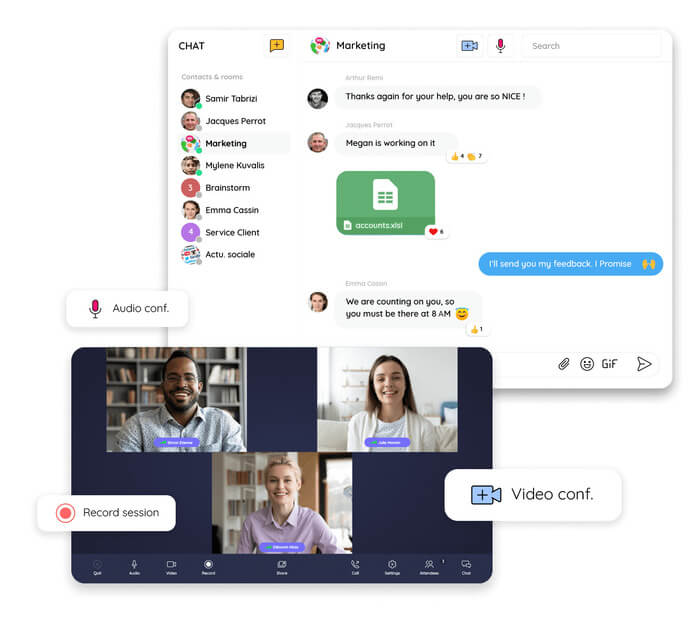There’s an old saying that a team is only as strong as its weakest player. But, if you subscribe to the school of collective intelligence, a team’s strength isn’t necessarily dependent on how strong or weak individual players are—but instead, on how strong those teammates are as a unit.
Investing the time to develop collective intelligence in your organization can lead to a variety of benefits to your company, including improved productivity and creativity, and a more efficient use of resources.
But how, exactly, do you develop collective intelligence within your organization—and use it to empower your team’s best work?
What is collective intelligence—and why is it important to develop it in your company?
Collective intelligence is a team’s combined intelligence. This shared (or group) intelligence happens when groups of people work together, contributing their individual thoughts, ideas, and experience to the collective. Over time, the knowledge of the group grows to a level that surpasses what any individual on the team could produce or ideate on their own.
And that shared intelligence? It can drive some serious benefits for your company.
Some key advantages of developing collective intelligence in your company include:
- Improves critical thinking and problem solving. Since everyone’s mind works differently, when teams work together to solve problems, each person on the team is exposed to different ways of thinking and processing. This collaboration and exposure to different schools of thought can lead to a deeper level of understanding among all contributors—and with that deeper understanding comes better problem solving.
- Boosts creativity and innovation. Let’s say your team is working on a new project. Each person on the team brings their individual ideas—and then the group builds on those ideas, moving forward with the strongest or, in many cases, combining the ideas to come up with something new entirely. This leads to more original, innovative ideas—and more of them.
- Increases employee engagement. When you foster collective intelligence with your staff, you’re giving each employee a voice. Everyone has the chance to contribute and have those contributions heard, considered, and valued. And when employees feel their contributions are recognized and valued, they’re more engaged with their work—and that engagement drives a higher level of performance. (A Gallup survey reveals that engaged employees increase productivity by 14% and increase organizational participation by 13%.)
Clearly, there are a number of benefits of collective intelligence. But how, exactly, do you develop that group intelligence within your organization?
Foster collaboration…
In order to develop collective intelligence, people need to work as a collective. However, not every team that works collaboratively is going to develop collective intelligence. If you want that collective intelligence to develop, you have to be purposeful about fostering the right kind of team collaboration.
So how do you do that?
Create diverse teams
Part of the power of collective intelligence is bringing people with different thinking and problem-solving styles together so they can learn from each other and produce better work as a group. So, if you want to develop collective intelligence in your company, you’re going to want to build diverse teams of people with different backgrounds, professional experience, and ways of approaching work. (And as a bonus? Diverse teams perform better overall. According to research from Boston Consulting Group, diverse work teams are more productive and produce 19% more revenue than less-diverse teams.)
Leverage emotional intelligence
People with high emotional intelligence (also known as EQ) have the ability to identify and manage their own emotions while also understanding and empathizing with the emotions of others—and if you want your team to develop collective intelligence, hiring employees with a high EQ is a must.
Why? Emotionally intelligent people understand how to work as a collective. They can share their own ideas and insights while creating space for others’ ideas and insights. They can actively listen to others. They’re less likely to get upset or reactive if the group decides to move forward with someone else’s plan or idea—all of which is critical for developing collective intelligence.
…but also give team members time and space to work on their own
To develop collective intelligence, people need to work together—but they also need time and space to develop their own ideas. For many people, having time to brainstorm and process information independently helps them to come up with more creative, original ideas—ideas they can then share with the collective to make the team stronger.
In addition, some employees may struggle with contributing or speaking up in high-pressure settings. (For example, introverts may not feel comfortable raising their hand or sharing ideas during remote meetings.) Make sure to find ways to accommodate different communication styles and comfort levels. Most conference call platforms now have video capabilities. Consider using an anonymous whiteboard for participants to contribute, or have team members submit ideas via a digital platform rather than sharing aloud during a team meeting. That way, everyone has the opportunity to contribute and help support the team’s collective intelligence—but in a way that works for them.
Create a sense of psychological safety
Collaboration is a huge part of developing collective intelligence. Each person on the team needs to feel comfortable enough to share their ideas with the team and work together to solve problems and make decisions. And effective collaboration can only happen when employees feel safe with their colleagues, their managers, and the organization as a whole.
Which is why, if you want to develop collective intelligence across your organization, creating a sense of psychological safety is non-negotiable.
Fostering psychological safety in the workplace takes time, but leaders can purposefully work toward creating a safe and welcoming company culture—the kind of environment that allows collective intelligence to grow.
A few ways to foster psychological safety include:
- Be open to feedback. Ask your employees for feedback—and ask them for feedback regularly. For example, you might schedule monthly one-on-ones between individual contributors and their managers, send out a quarterly survey, and/or schedule twice-a-year sit-downs with your leadership team. Give your team the chance to voice concerns, make suggestions, and share what they’d like to see change. (And don’t forget to ask them what’s going well—and what they’d like to see more of.)
- Listen and take action. It’s one thing to ask for feedback. But for that feedback to have a real impact, both on your team and your organization as a whole, you need to actively listen to your employees’ input—and then take action. Show team members they have your attention by asking questions, making eye contact, and giving other nonverbal cues (like head nods and affirming facial expressions). Repeat their input back to them so they know you understand—and then (and this is the important part!) act on that feedback whenever possible. Actively listening to your employees’ feedback—and then putting that feedback into place within your organization—shows your team you take their opinions seriously and are willing to make changes to create a better, more supportive workplace.
- Model authenticity and empathy. A healthy company culture starts from the top—and if you want to build a psychologically safe workplace, leaders need to model the kind of behavior that’s going to make employees feel safe. (For example, managers should be transparent with their employees, show empathy in the way they communicate, and have a zero-tolerance policy for bullying or intimidation.)
- Build a supportive culture in which mistakes are okay. Part of psychological safety is feeling safe to make mistakes. Managers should encourage their employees to take risks—and it’s ok if those risks don’t pay off. And if you, as a leader, make a mistake, acknowledge it, openly work to fix it, and move on. That way, you can show your team that making mistakes actually is ok.
Invest in the right tools
If you want to develop collective intelligence in your company, you need the right strategy. But you also need the right technology—and that technology is Talkspirit.
Talkspirit is an all-in-one collaborative work platform that comes equipped with all the features you need to develop collective intelligence in your company—features that include:
- surveys to collect feedback,
- a chat and video conference platform,
- a shared drive and library to store team documents and resources,
- a project management feature to organize your project,
- and a news feed that allows you to continually push out pertinent information across your organization.

With Talkspirit, you can empower your team to do their best work—and to do that work together as they develop the group intelligence needed to take your business to the next level.
Ready to experience how Talkspirit can help you develop collective intelligence in your organization? Schedule a demo or sign up for a free trial today!



